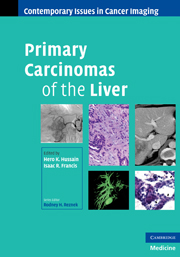Book contents
- Frontmatter
- Contents
- Contributors
- Series foreword
- Preface to Primary Carcinomas of the Liver
- 1 Epidemiology of hepatocellular carcinoma and cholangiocarcinoma
- 2 Surveillance and screening for hepatocellular carcinoma
- 3 Pathology of hepatocellular carcinoma, cholangiocarcinoma, and combined hepatocellular-cholangiocarcinoma
- 4 Radiological diagnosis of hepatocellular carcinoma
- 5 Staging of hepatocellular carcinoma
- 6 Surgical treatment of hepatocellular carcinoma: resection and transplantation
- 7 Non-surgical treatment of hepatocellular carcinoma
- 8 Radiological identification of residual and recurrent hepatocellular carcinoma
- 9 Radiological diagnosis of cholangiocarcinoma
- 10 Staging of cholangiocarcinoma
- 11 Treatment of cholangiocarcinoma
- 12 Uncommon hepatic tumors
- Index
- Color plates
- References
10 - Staging of cholangiocarcinoma
Published online by Cambridge University Press: 04 August 2010
- Frontmatter
- Contents
- Contributors
- Series foreword
- Preface to Primary Carcinomas of the Liver
- 1 Epidemiology of hepatocellular carcinoma and cholangiocarcinoma
- 2 Surveillance and screening for hepatocellular carcinoma
- 3 Pathology of hepatocellular carcinoma, cholangiocarcinoma, and combined hepatocellular-cholangiocarcinoma
- 4 Radiological diagnosis of hepatocellular carcinoma
- 5 Staging of hepatocellular carcinoma
- 6 Surgical treatment of hepatocellular carcinoma: resection and transplantation
- 7 Non-surgical treatment of hepatocellular carcinoma
- 8 Radiological identification of residual and recurrent hepatocellular carcinoma
- 9 Radiological diagnosis of cholangiocarcinoma
- 10 Staging of cholangiocarcinoma
- 11 Treatment of cholangiocarcinoma
- 12 Uncommon hepatic tumors
- Index
- Color plates
- References
Summary
The goal of diagnostic staging of cholangiocarcinoma is to evaluate resectability and extent of surgery, because surgery is the only curative therapy. Cure and long-term survival can be achieved if the tumor is completely excised and the histologic margins are negative.
Staging of mass-forming intrahepatic cholangiocarcinoma is performed using contrast-enhanced MRI or CT. The extent and number of tumor nodules, associated portal vein narrowing or occlusion, and the presence of lymph node and distant metastasis are important determinants of survival after surgery.
Extrahepatic cholangiocarcinoma is more challenging and may require more than one imaging modality for staging. Extrahepatic tumors are classified according to their anatomical location into perihilar (Klatskin) and distal tumors. Perihilar cholangiocarcinoma is typically located in the extrahepatic duct proximal to the insertion of the cystic duct. Distal tumors arise anywhere from below the confluence of the cystic duct with the common bile duct to the ampulla of Vater. In this chapter, we focus on the staging and preoperative evaluation of extrahepatic cholangiocarcinoma.
Perihilar extrahepatic cholangiocarcinoma
The preoperative evaluation of perihilar cholangiocarcinoma must address four critical determinants of resectability:
Extent of tumor within the biliary tree,
Vascular invasion,
Hepatic lobar atrophy, and
Metastatic disease
In the absence of metastatic disease, the location and extent of tumor spread along the bile ducts will determine whether it can be completely excised.
- Type
- Chapter
- Information
- Primary Carcinomas of the Liver , pp. 160 - 176Publisher: Cambridge University PressPrint publication year: 2009



